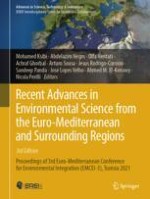This edited book includes over one hundred and eighty short papers that were presented during the third edition of EMCEI, which was held in Sousse, Tunisia, in June 2021. Nowadays, experts as well as most of the general public know that the Mediterranean and surrounding regions are facing environmental degradation that is accelerating at an unprecedented rate. The main causes are the natural and human induced climate change, increasing pollution, urban growth, and the overexploitation and unsustainable use of resources due to rapid population growth. The effects are seen in several indicators such as the warming, more frequent extreme events, severe droughts, water shortages, contraction of natural resources, changes in land use and landscape deterioration, decreasing agricultural yields, biodiversity loss, deterioration of the ecosystems, corrosion of the natural coastal environment, sea-level rise, and ocean acidification. In addition to these more recent issues, the Mediterranean and surrounding region naturally experience a number of hazards such as floods, droughts, desertification, fires, catastrophic forest diebacks, earthquakes, and volcanic eruptions. By presenting a wide range of environmental topics and new findings relevant to a variety of problems in these regions, this book appeals to anyone working in the subject area and especially students interested in learning more about new developments in environmental research initiatives in light of the worsening environmental degradation of the Mediterranean and surrounding areas, making environmental and resource protection an increasingly important issue that impedes sustainable development and social well-being. The book addresses emerging environmental issues along with new challenges by focusing on innovative approaches that contribute to achieving a sustainable environment in and around the Mediterranean Sea and by highlighting to decision makers from relevant sectors the environmental considerations that should be integrated into their own activities.
